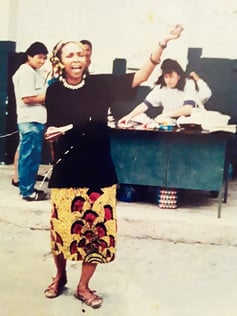Presented by Museum of the Peace Corps Experience and American University Museum
c. 1994–96
Pimampiro, Imbabura, Ecuador
Courtesy of Rosemarie Ricks, Ecuador, Pimampira 1994–96

I was born in the Republic of Panama and grew up speaking Spanish. In Ecuador I was assigned to an area where the fetal and childbirth mortality rates were extremely high. As an RN/CNM, this was a fantastic assignment.
The welcome mat was not obvious during my first weeks in Pimampiro. The local Catholic priest had cautioned the community that I was an evangelist. I decided to attend Mass, sat in the back row, and went to receive communion. The word spread and the priest became a friend. Many women came to the clinic for prenatal and postpartum care.
I traveled to outlying villages, such as Chalguaycua and Sanchipamba, and gave talks about sanitation, nutrition, and the impact of hygiene on health. I identified the local midwives and provided information that led to changes. Ultimately these efforts reduced infections in these communities.
I visited the Black community of Chuga whose residents were referred to as morenos and “lost people.” These were some of the most beautiful Black people I’ve ever seen. I was able to relocate the clinic from a hot, desolate, dirty spot of pavement to a more suitable site. The morenos came to see me in large numbers for pre- and postnatal visits.
Boosting self-esteem was important. I said, “You folks look like me. I’m not lost—and neither are you. In this community we have problems that we’re going to solve together.” Instead of drawing water where garbage accumulated, I told them to draw their water upstream and boil it. With simple measures, illnesses decreased.
Everywhere I went I talked about diet, washing hands, and basic sanitation. After a talk at a school in Pimampiro, a young boy followed me and said, “You told us boys have two eggs, but I have three—and one of them hurts.” He had a hernia, and I was able to arrange surgery for him.
I persuaded merchants to support health fairs in local schools. They were a huge success. I also was responsible for training and supervising 13 midwives. Over time fetal and maternal death rates began to decrease.
Besides my ability to speak Spanish, I enjoyed another advantage. As a Black American from Bedford-Stuyvesant in Brooklyn, I understood that poor people usually have to fight to get what they deserve. The Peace Corps didn’t teach me this. Life did.
Museum of the Peace Corps Experience
PO Box 2427
Oregon City, OR 97045
USA
The Committee for a Museum of the Peace Corps Experience is a 501(c)(3) private nonprofit organization. Tax ID: EIN # 93-1289853
The Museum is not affiliated with the U.S. Peace Corps and not acting on behalf of the U.S. Peace Corps.
Museum of the Peace Corps Experience © 2024. All Rights Reserved.